GenusLaetacara, Kullander, 1986
Text and photos by Alf Stalsberg,
|
The Genus Laetacara was created in 1986 by Dr Sven O. Kullander of the Swedish Museum of Natural History. In his revision of the Genus Cichlasoma in 1983 he placed these fishes in the "Aequidens" dorsiger group. There are at least two undescribed species belonging to the Genus Laetacara, but Dr Kullander refers to three species.
The two Laetacaras known in the hobby are Laetacara sp. "Buckelkopf" and Laetacara sp. "Orangeflossen". It was Ingo Koslowski in Gelsenkirchen, Germany who gave these two their names. Erik Åhlander at the Swedish Museum of Natural History has been working with the Laetacara sp. "Orangeflossen" for many years. Not continuously, but off and on. And I have been waiting for a name on this fish for years. Dr Kullander refers to a paper in his book in 1986, that Laetacara will be dealt with more extensively by Åhlander & Kullander but, so far nothing has been published.
I collected Laetacara sp. "Orangeflossen" in Colombia in 1991 and in 1993 in the Province of Guainia out in Puerto Inirida. One of the places was in Rio Atabapo, another place was in Caño Caiman and the third place was in a very small lake south of the town off Puerto Inirida. The lake was called Lagona Coco. The property the lake was on was owned by an old lady, she gave us permission to visit the lake and collect fish there.
Well something has happened at last, and that is that the fish we have for many years called Laetacara sp. Orangeflossen has finally been described.
Laetacara curviceps
Male Laetacara curviceps with fry. |
Laetacara curviceps is probably still better known as "Aequidens" curviceps. It will take some time before people get used to the new name. Personally I think that the new name should be well-known. After all it has 10 years since the new Genus was created.
This fish has been one of the most popular cichlids among aquarists. Easy to keep and breed, does not harm other fish, and has been available in the hobby most of the time. Many articles have been written, pages up and pages down, about the fish, so there is no need for me to tell you more about it. You will find it in almost all books about aquarium fish.
Laetacara dorsigera
| ... |
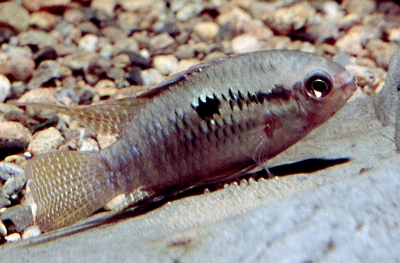
The female lays eggs, but does not even have nice dark color. |
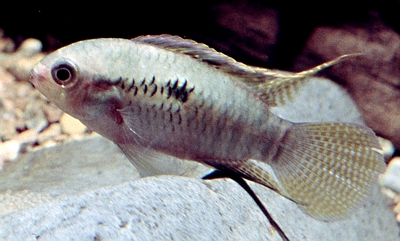
The same applies to the male, playful colors are not turned on yet. |
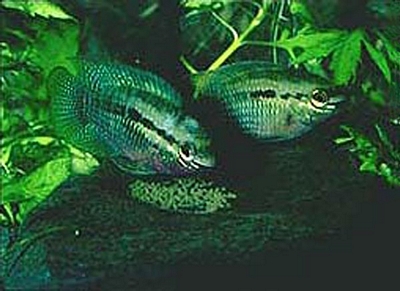
A pair of Laetacara dorsigera with eggs. |
This Laetacara dorsigera has been one of the most common Laetacaras seen in aquarium shops and in aquarists' aquariums in these past few years. It's a very nice fish, does not harm any other fish, does not dig up plants and so on. No wonder this fish has gained such popularity. When this fish showed up in the hobby, it was as a "contaminant" among many Laetacara curviceps. So in the beginning no one could tell exactly where the fish was collected. But aquarists went out there and made collections, so now we all know from where the fish comes from.
Laetacara flavilabris
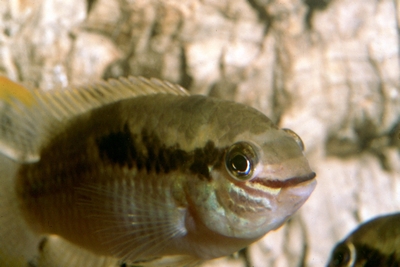 Smiling acara. |
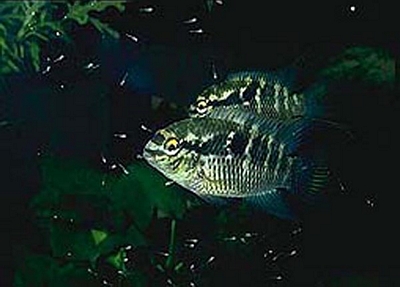
A pair of Laetacara flavilabris with fry. |
When I first came in contact with this fish, it was through Dr Kullander, he had brought adult fish back from a collecting trip in Peru and they spawned in his tank.
He was kind enough to let me have some small fry and I was able to raise them to be very nice adult fish. And the result is in the photo of the fish. The fish were very shy in the beginning, and they would panic easily. But that was more or less in the beginning. The color on the fish outside mating time is rather dull, but the lines around the mouth made Langhammer give the fish the name, "The Smiling Acara". They don't seem to be bred much, you usually find them in shipments direct from Peru. If you have the chance to look at a shipment of fish from Peru, look for this fish, Laetacara flavilabris.
Laetacara thayeri
Laetacara thayeri. |
The photo of this fish is taken by my friend Ingo Koslowski in Gelsenkirchen, Germany. I also got some of his Laetacara thayeri, but they were probably too old when I got them, so I never managed to breed them. Nor did I manage to take a photo of the fish while I had them and I have never had them since then, and that was in 1985.
So I am sorry that I can't give you any more information about the fish, since I have had no personal experience with them. If you want scientific material about the fish then I will highly recommend Dr Kullander's book "Cichlid fishes of the Amazon River drainage of Peru", from 1986.
Laetacara araguaiae (formerly Buckelkopf)
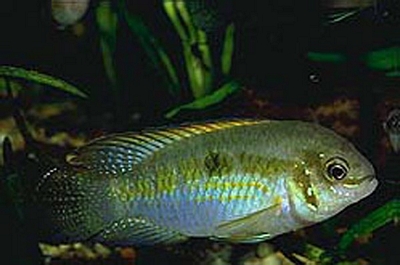 |
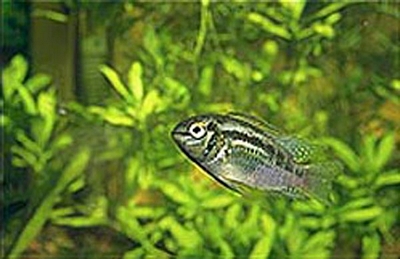
ABOVE: A female Laetacara araguaiae. LEFT: An elderly male. |
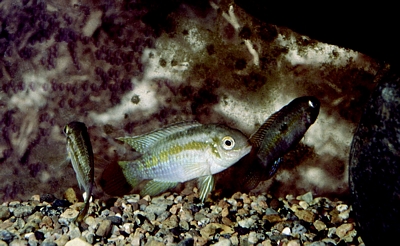
... |
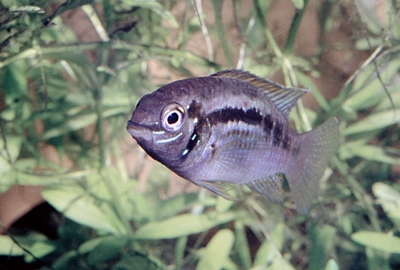
The characteristic angled line that goes down the gill cover is clear in this picture. |
A young pair with fry |
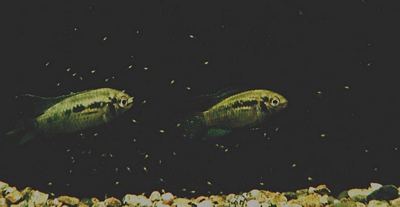 |
Well at last, on 15 May 2009, this fish (formerly Laetacara sp. "Buckelkopf") was also described.
This small and lovely little fish deserves a larger distribution in the aquarium hobby. Of course it has the same drawback as a lot of South American cichlids, they are rather dull in color while they are small. But if you give them a chance, they will pay you back in full; nice colors, interesting behavior and a fish you can keep together with almost anything.
They are rather easy to breed, and the fry are very small, but if you have microworms and newly hatched brine shrimp, there will be no problem.
As all fish do, Laetacara also prefer clean clear water, and I change half the water in my tanks every week. By doing this, you will keep a good water quality. Of course I know that not all of you have such water in your tap that you can use it directly in the tank as I do, but have to prepare the water first. But do it, the fish will pay you back.
The male Laetacara sp. "Buckelkopf" pictured here is also good looking. The name "buckelkopf" refers to the hump on the forehead. None of my fish/males have got this hump, but it might come as they grow older or they are fed heavily. Then they might develop a hump you can call as they do in German, Buckelkopf.
Laetacara fulvipinnis
(Laetacara sp. "Orangeflossen")
Laetacara sp."Orangeflossen" |
This is my last one in the Genus Laetacara and this is the one I have been waiting on for years for a name. I hope that Dr Kullander and Erik Åhlander soon will publish the paper Dr Kullander refers to in 1986 in his book "Cichlid fishes of the Amazon River drainage of Peru", on page 321. (See text at the top of this page Genus Laetacara).
Well, at last this fish has now got a name, after I have been waiting on it for a very long time. The name is Laetacara fulvipinnis it seems that Dr Wolfgang Staeck and Dr Ingo Schindler also thought it was time. So finally, last year the published paper came and I'm very glad for that. If you want to read the whole description then here is the text. "Description of Laetacara fulvipinnis sp. n. (Teleostei: Perciformes: Cichlidae) from the upper drainages of the rio Orinoco and rio Negro in Venezuela". You can also download it from the net.
So I hope this will satisfy you too.
|
Laetacara fulvipinnis is a calm and nice fish, maybe a little shy, but seen in breedings color is quite a different fish. |
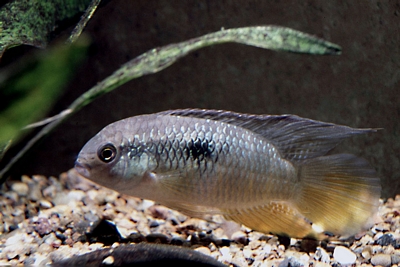
Laetacara fulvipinnis in daily colors in the aquarium. |
In the biotope there were also Dicrossus filamentosus and Apistogramma, tetras and other fish too. Later Dr Ingo Schindler and Dr Wolfgang Staeck described a new Dicrossus from these parts, and that is Dicrossus gladicauda it was published in May 2008. You can download the description.
Here we are in the biotope in Caño Caiman, and as you can see there are a lot of logs and branches in the water. This did not make it easier to collect fish. |
Cichlid Power,
Alf
DISCLAIMER: Statements made on this page are not herewith made available for the purpose of zoological nomenclature
under the International Code of Zoological Nomenclature.
Copyright 1995- Alf Stalsberg – Cichlid Power